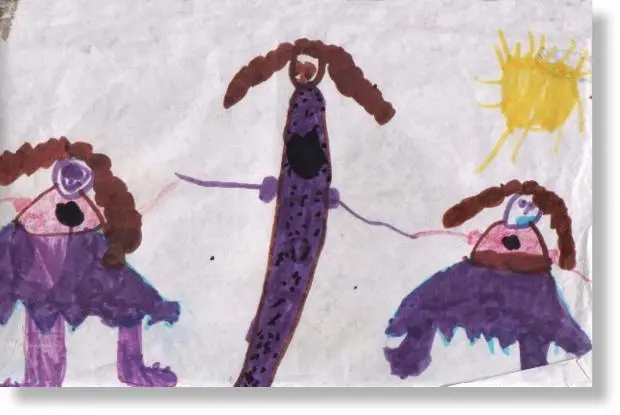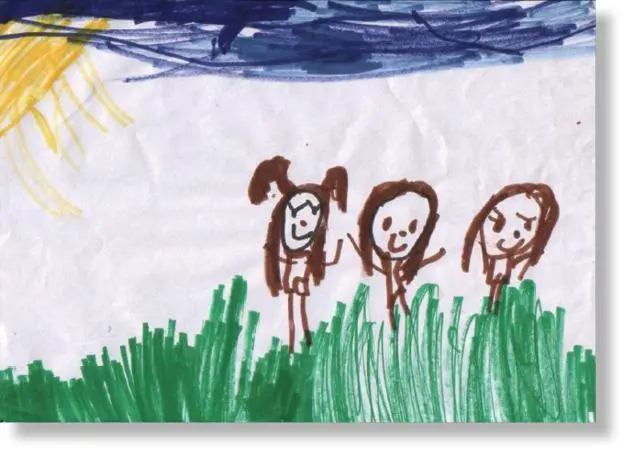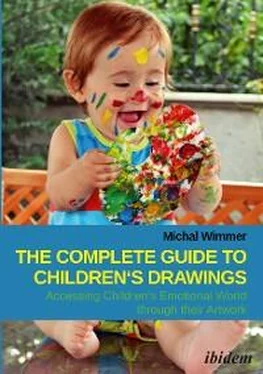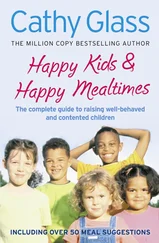
Figure 2-9:Excessive use of purple
This drawing is an example for exaggerated use of purple. The excessive use of purple symbolizes the girl’s connection to her childhood experience, in the simplest sense of what it means to be a child. Note that although this girl is very in touch with her intuition, this connectedness to her childish side clashes with daily demands by her parents who think she is not grounded enough in reality.
Green
Green often appears in children’s drawings as it is also common in nature. Children are aware of the green color of tree and plants, but do not always use it when drawing them.
Historically, green symbolized victory. Green bay leaves were laid on the victor’s head in ancient Greece. In ancient Egypt temple floors were painted green as a sign of success and victory. In addition, green was considered symbolic of resurrection and immortality. Nowadays, green is often used symbolically in many African countries to represent natural richness, but also in Islamic countries, because it is considered by Islam to be sacred, as it is symbolic of the lushness of paradise. Green is also associated with prosperity, as in the dollar bills.
Since green is a cold color, it is usually considered calming and harmonizing. For example, green is used in billiard or card games tables, because it creates harmony between the gamblers. In medicine, green is often used in surgery rooms or clinics, to create a relaxing atmosphere.
Culturally, we associate green with envy, as well as with beginnings (“green light”). Politically, green represents environmental activism.
According to Lüscher, green is symbolic of willpower, diligence, stability, self-awareness and self-esteem. Green is characterized by precise, factual and critical assessment. It is also associated with efficiency. In addition, Lüscher sees in green a symbol of one’s will to outstand, impress, dominate and receive recognition from others, in order to boost one’s self-confidence. Kandinsky and Goethe both share the opinion that green projects peacefulness, stability and quietness.

Figure 2-10:Excessive use of green
In children’s drawings green symbolizes many characteristics of childhood such as fresh start, different and unique view of situations, learning and a need for space. Consequently, green appears more often in drawings of children who like nature and outdoor games.
This drawing was made by a 5 year-old. No need to refer to the grass or stalk which are naturally green. However, it is clear that the child chose not to use any other colors, so that the house is made of green contour lines, as well as green windows and door.
Recall that we must examine a large number of drawings in order to draw conclusions about the child’s personality. In this case, as in other drawings by the same child, green is used extensively. Excessive use of this color may indicate compensation, for example, for the child’s need to learn, start anew and blossom.
In the case of this particular child, excessive use of green indicates his fears of learning. At the time of this drawing, the child started first grade and was afraid of studying and found it difficult to manage in class, mainly due to motoric difficulties not diagnosed before my analysis of his drawings. This child used to sit next to his classmates in front of the teacher and blackboard but could not compare himself to their capabilities, mainly because he could not copy quickly enough from the board. As already noted, the combination of excessive coloring with graphic indicators, such as the shaky lines representing the house walls and roof, lends further support to my conclusion regarding his emotional difficulty.
Gray
In nature gray is associated with fall and wintery weather. In many languages, a “gray” face is a weary facial expression. Gray life is a meaningless and boring life, and a gray job is similarly boring and lacking in glory. Nevertheless, somewhat ironically, shades of gray represent a balance point of view, as opposed to the sharp dichotomy of black and white.
The brain tissue is called “gray matter”, associating the color with thinking. The term “gray market” refers to semi-legal economic activity. Finally, a “gray area” represents territories or activities known to be problematic but that is not dealt with specifically by the law or enforcement authorities.
Lüscher associates gray with neutrality, a wish to “sit on the fence”, but also a border. This is why we often observe gray boundaries in drawings, which protect the painter from external threats.
In children’s drawings, gray is usually used topically, as in gray clouds. In addition, gray, just as any other color, has a range of qualities – positive and negative. Children tend to use gray mainly in its negative aspects. However, gray may also indicate positive aspects such as the ability to integrate or perform measured steps. Remember that the color analysis must be supported by other indicators, primarily graphic indicators and that it is this combined analysis that will determine the meaning of the color.
Brown
Brown is the most dominant color in nature besides green. It appears in landscapes, plants, animals, as well as in the color of our eyes, skin and hair.
Lüscher refers to brown as a symbol of sensation. Meaning, brown is the reflection of our physical aspect. In addition, it was found that when a person feels uncomfortable with his family, or experience physical insecurity or discomfort, he will tend to choose brown. That is, the choice of brown indicates an increased need for physical and sensory comfort. This could indicate lack of confidence or actual physical illness. The lack of confidence could stem from conflicts or problems the person feels unable to cope with.
In most cases, brown will be used realistically in children’s drawings. For example, the earth will often be painted in brown. Exaggerated use of brown indicates difficulty to deal with changes and tendency to prefer the well-known and familiar.

Figure 2-11:Excessive use of brown
The following example represents excessive use of brown. The child draws all figures completely brown, without any distinctions among body organs: eyes, eyelashes, noses, mouths, arms and torsos are all brown. Usually, in drawings by children her age, human figures are more colorful and their organs more distinct.
All shades of brown are characteristic of the human skin. Therefore, it may be that this girl attempted to find a color similar to natural body colors. However, other drawings by the same girls are also characterized by excessive use of brown. This means the girl may have needs associated with using that color, such as groundedness, stability, earthliness and confidence. She needs to know what is going on around her, down to the smallest details, to feel that confidence, otherwise she may suffer anxiety.
Black
One of the most commonly asked questions about children’s drawings is about the meaning of black. In western culture black symbolizes mourning, bereavement or depression. However, in other countries and cultures white is used to represent these situations and sentiments. In western society, if a person had a rough day, he would say that he had a black day. Black is also associated with dark and mysterious events – for example, a black cat as a sign of the evil eye, black lists, black humor and black magic.
Читать дальше















